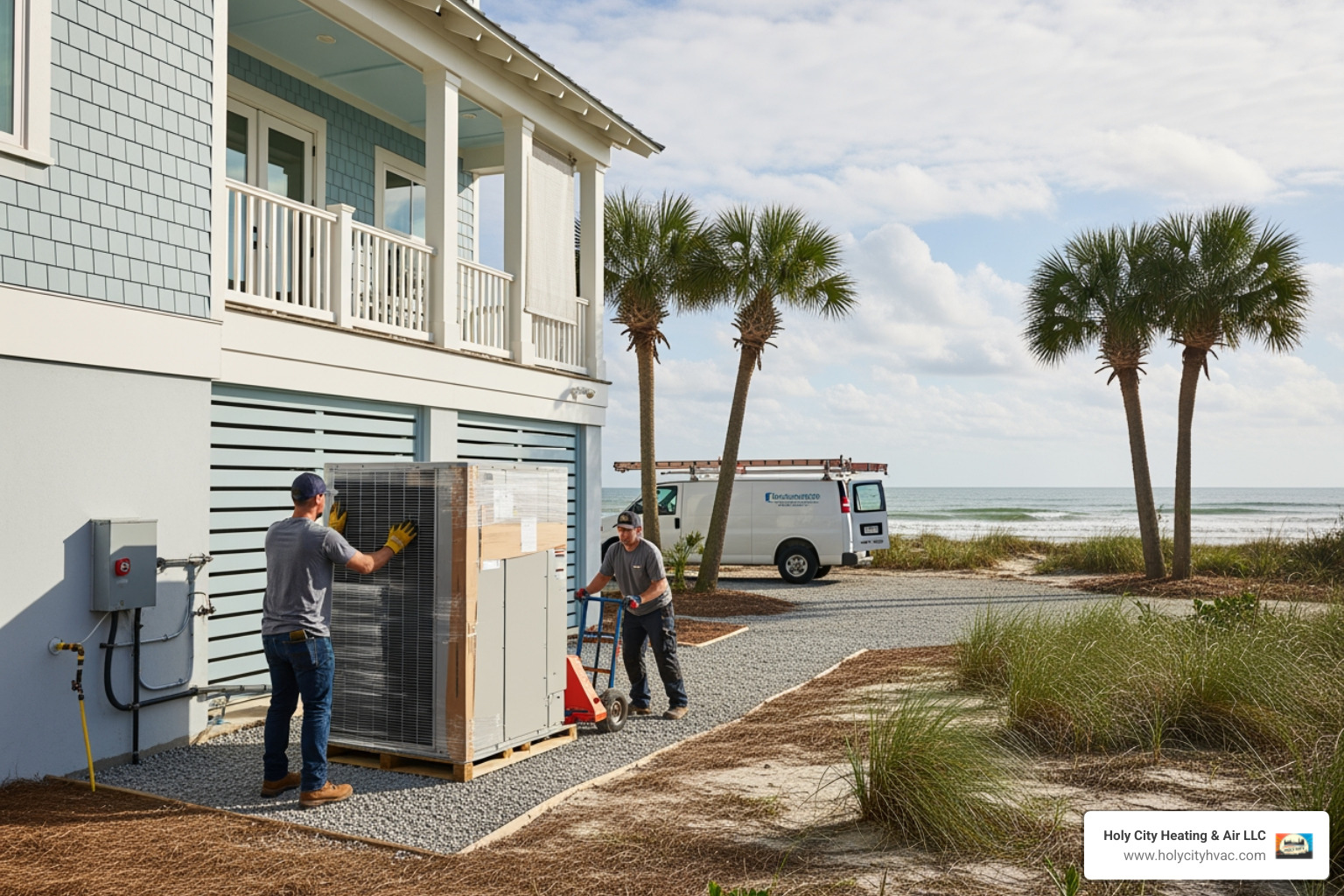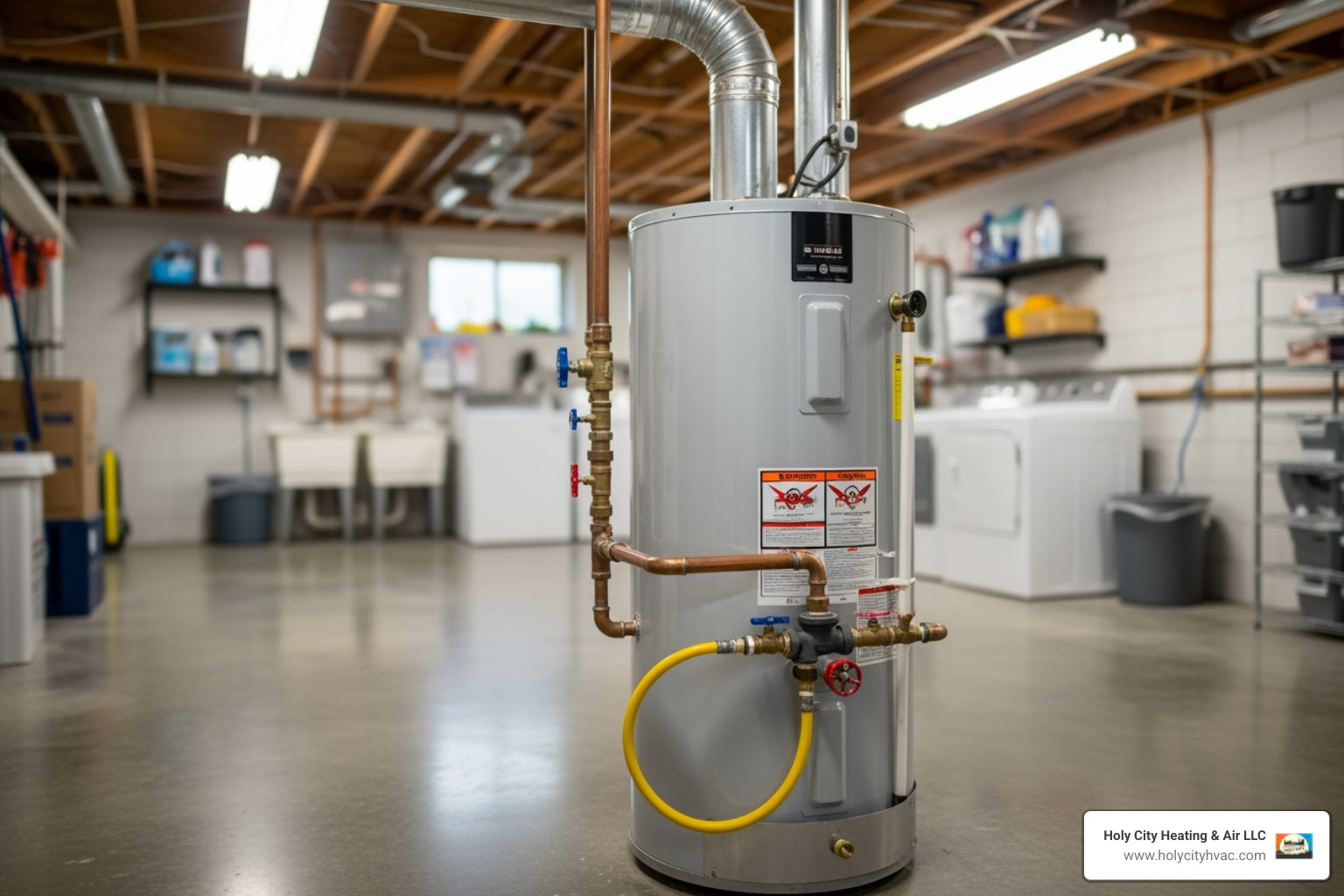
Why Low Water Pressure Frustrates Charleston Homeowners Every Day
Low water pressure turns simple daily tasks into time-consuming ordeals. When you turn on your shower expecting a refreshing spray, only to get a disappointing trickle, you know something's wrong.
Quick Solutions for Low Water Pressure:
- Single fixture problem - Clean clogged aerators and showerheads with vinegar
- Whole house issue - Check that main shut-off valve is fully open
- Pressure too low - Test with gauge (normal range is 40-60 PSI)
- Hidden leaks - Look for water stains, damp spots, or high water bills
- Old pipes - Galvanized steel pipes corrode after 20 years and need replacement
Research shows that normal water pressure should be between 40 and 60 PSI, with most homeowners preferring around 50 PSI. If your pressure drops below 40 PSI, it's time to take action.
The good news? Many water pressure problems have simple fixes you can handle yourself. Others require professional help, especially when dealing with corroded pipes or faulty pressure regulators.
This guide walks you through a systematic approach to diagnose and fix your water pressure issues. You'll learn when to grab your toolbox and when to call a trusted plumber in the Charleston area.
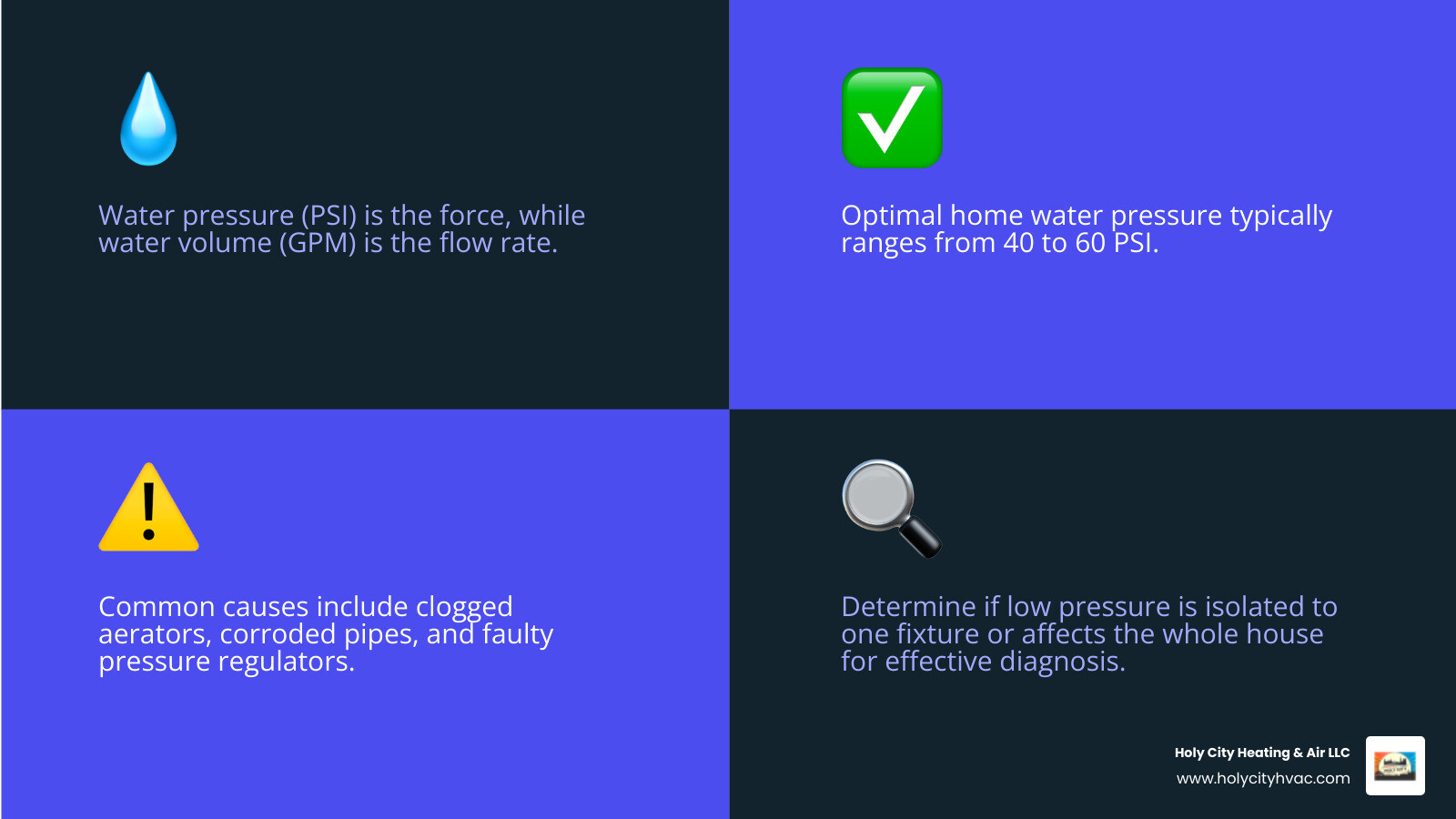
Step 1: Diagnose the Problem - Is It Just One Faucet or the Whole House?
Before you start any repairs, the first step is to determine if the low water pressure is affecting a single fixture or your entire house. Walk through your home and test every faucet, shower, and water-using appliance, paying close attention to the flow.
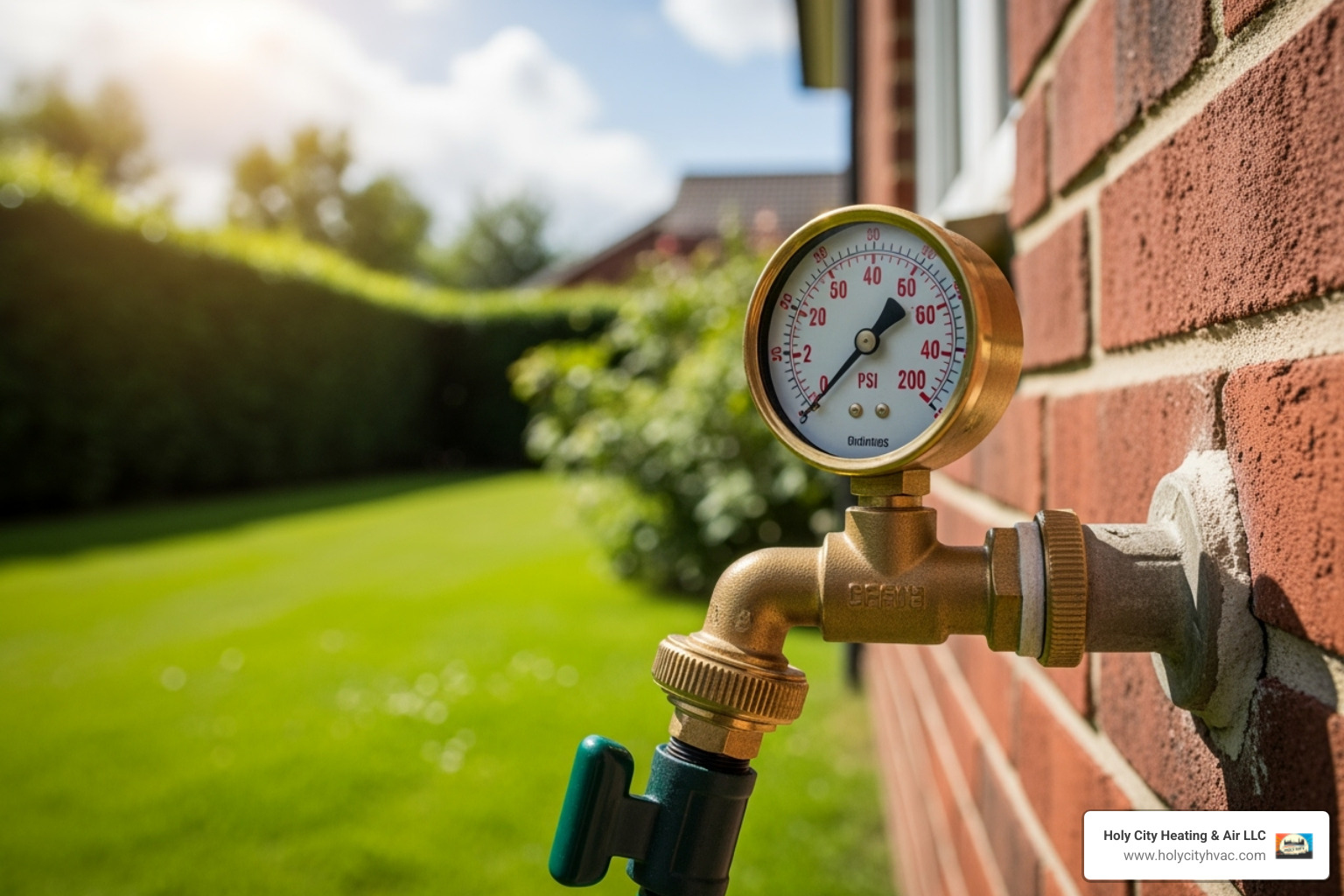
Use a water pressure gauge (available at hardware stores) to get a precise reading. Screw it onto an outdoor hose spigot, turn off all other water in the house, and then open the spigot fully.
The ideal range is 40 to 60 PSI (pounds per square inch). Most Charleston homeowners prefer around 50 PSI. A reading below 40 PSI confirms you have low water pressure.
Next, check your water meter. With all water off in the house, look at the meter. If it's still spinning, you likely have a hidden leak that's reducing your pressure.
Don't forget to check with your neighbors. A quick chat might reveal whether this is a personal problem or a neighborhood-wide issue, such as a water main break or peak usage.
How to Fix Low Water Pressure at a Single Fixture
If only one faucet or shower has low pressure, the fix is often simple. The most common culprit is a clogged aerator—the small screen at the tip of the faucet. These can easily get blocked with mineral buildup and debris, a frequent issue with Charleston's water.
To fix it, unscrew the aerator and soak it in white vinegar overnight. In the morning, scrub it with an old toothbrush to remove any remaining debris.
Showerheads get the same treatment. If you can't unscrew yours, fill a plastic bag with vinegar, secure it around the showerhead with a rubber band, and let it soak.
If cleaning doesn't work, the issue could be a faulty fixture with worn-out parts. Before replacing it, check the supply valve under the fixture. Make sure it's turned fully counterclockwise (open), as a partially closed valve is a common culprit.
Addressing Low Water Pressure Throughout the House
If every tap in your house has low pressure, you'll need to investigate your home's main water supply and plumbing system.
Start with your main shut-off valve, which controls all water entering your home. It's usually located where the water line enters the house. Ensure it's fully open (turned completely counterclockwise), as it may have been partially closed after maintenance.
Next, check the water meter valve by the street. This is your water company's responsibility, but it should be fully open. If it looks partially closed, call your utility provider.
Your pressure regulator (or pressure reducing valve) could also be the issue. This device, located on your main water line, reduces high municipal pressure to safe levels for your home. They can fail after 10-15 years, affecting your entire house.
Corroded pipes are another common villain, especially in older Charleston homes with galvanized steel pipes. Over decades, rust and mineral deposits build up inside, restricting water flow.
Hidden leaks can steal pressure without leaving obvious puddles. Look for high water bills, damp spots, or the sound of running water when all taps are off.
Finally, a water softener system can sometimes restrict flow. We cover how to test for this in our FAQ section.
Step 2: Uncover the Common Causes of Low Water Pressure
Now that you've determined whether your low water pressure is localized or house-wide, you can pinpoint the cause. Understanding the source of the problem is key to finding the right solution.
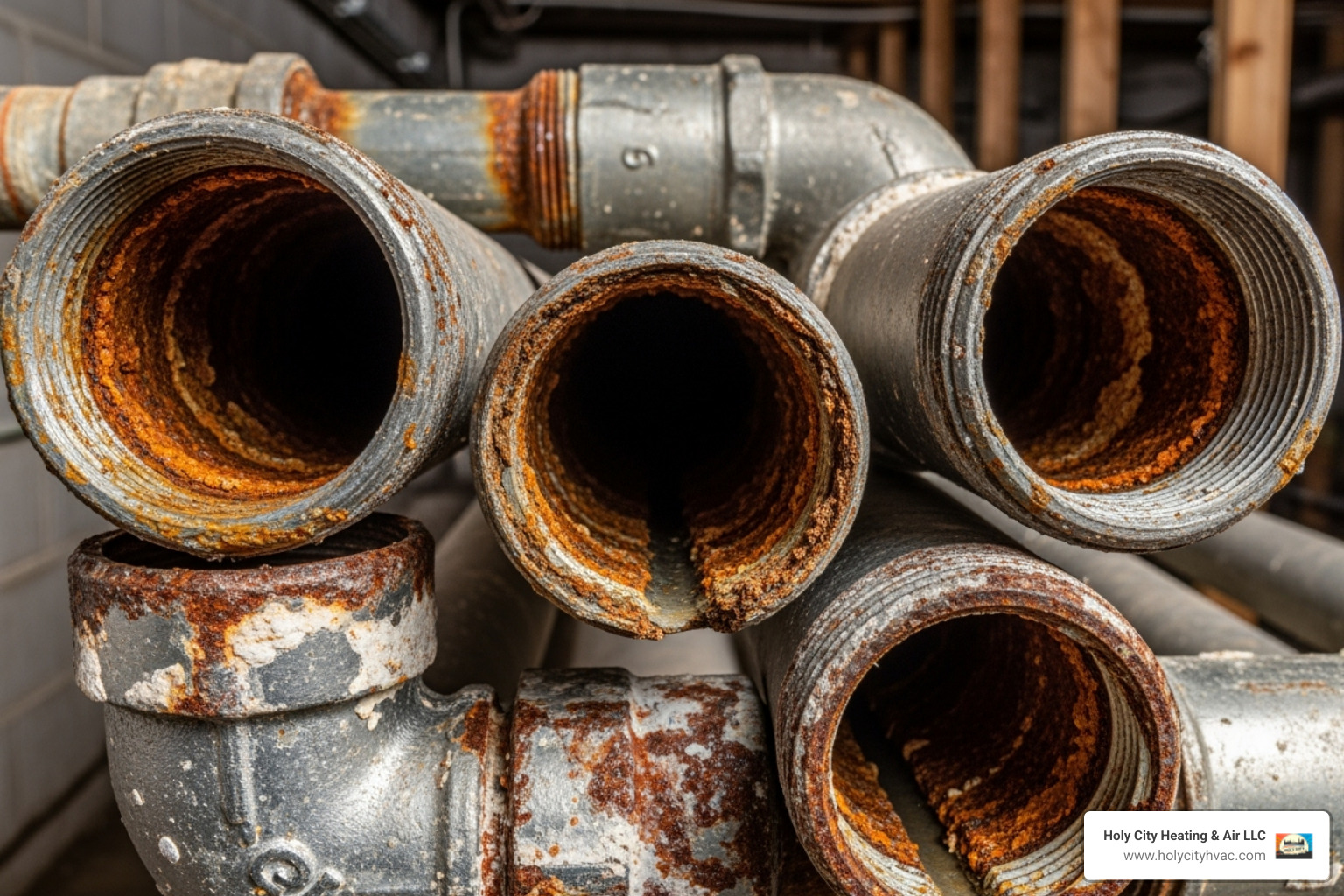
Let's explore the common external and internal factors that lead to low pressure.
Municipal and External Factors
Sometimes the problem originates outside your property line.
Water main breaks are a dramatic external cause. When a main line ruptures or the city performs maintenance, entire neighborhoods can experience pressure drops. Check with neighbors first. If they have the same issue, it's likely a municipal problem. Your local water utility's website often has real-time updates, or you can call them.
Peak usage hours can also cause temporary drops in pressure. When everyone in the neighborhood uses water at the same time (mornings and evenings), the collective demand can lower the pressure for everyone. This is normal.
High elevation can be a factor if you live on a hill. Water pressure naturally decreases as elevation increases. If your home is higher than the local water tower, you might consistently have low pressure.
Some older neighborhoods have shared water lines, meaning your neighbor's water usage can directly impact your pressure.
Internal Plumbing Problems
Most low water pressure problems start within your home's plumbing.
Hidden water leaks can go unnoticed for months, significantly reducing your pressure while increasing your water bill. Signs include: unexplained high water bills, damp spots or water stains, the sound of running water when taps are off, musty odors, warm spots on the floor, and a running water meter when no water is in use.
A failing pressure regulator (PRV) is another common issue. These devices keep pressure consistent and safe, but when they fail (typically after 10-20 years), you may notice fluctuating pressure, irregular flow, or noises from your pipes.
Partially closed valves can restrict flow. Check your main shut-off valve and any inline valves to ensure they are fully open (turned counterclockwise).
Clogged pipes develop as mineral deposits and rust build up, narrowing the passage for water. This is common in homes with older galvanized steel pipes (lasting ~20 years). Brass pipes last 40-70 years, and copper pipes can last over 50 years.
Your water heater can also be a source of low pressure. Sediment can accumulate in the tank and restrict hot water flow, causing low pressure only on your hot water lines.
Appliance and Fixture Faults
Sometimes the problem is at the point of use.
Clogged faucet aerators and showerhead restrictors are the most frequent cause of localized low pressure. They easily collect mineral deposits and debris.
Water softener malfunctions can cause house-wide low pressure. The resin bed can become clogged, or the system may be too small for your home's needs. They typically last 10-15 years. You can test this by using the bypass valve; if pressure improves, the softener is the issue.
Combi boiler systems heat water on demand, so low mains pressure will result in weak hot water flow. Traditional pumps don't work with these systems, so solutions are limited.
Gravity-fed systems depend on the height of your water tank (usually in the attic). If the tank isn't high enough above your fixtures, you'll have low pressure, especially for hot water. A dedicated pump can often solve this.
Step 3: DIY Solutions to Boost Your Water Pressure
Many low water pressure problems can be fixed without calling a plumber. With a few basic tools and some patience, you can try these DIY solutions to restore your water flow.
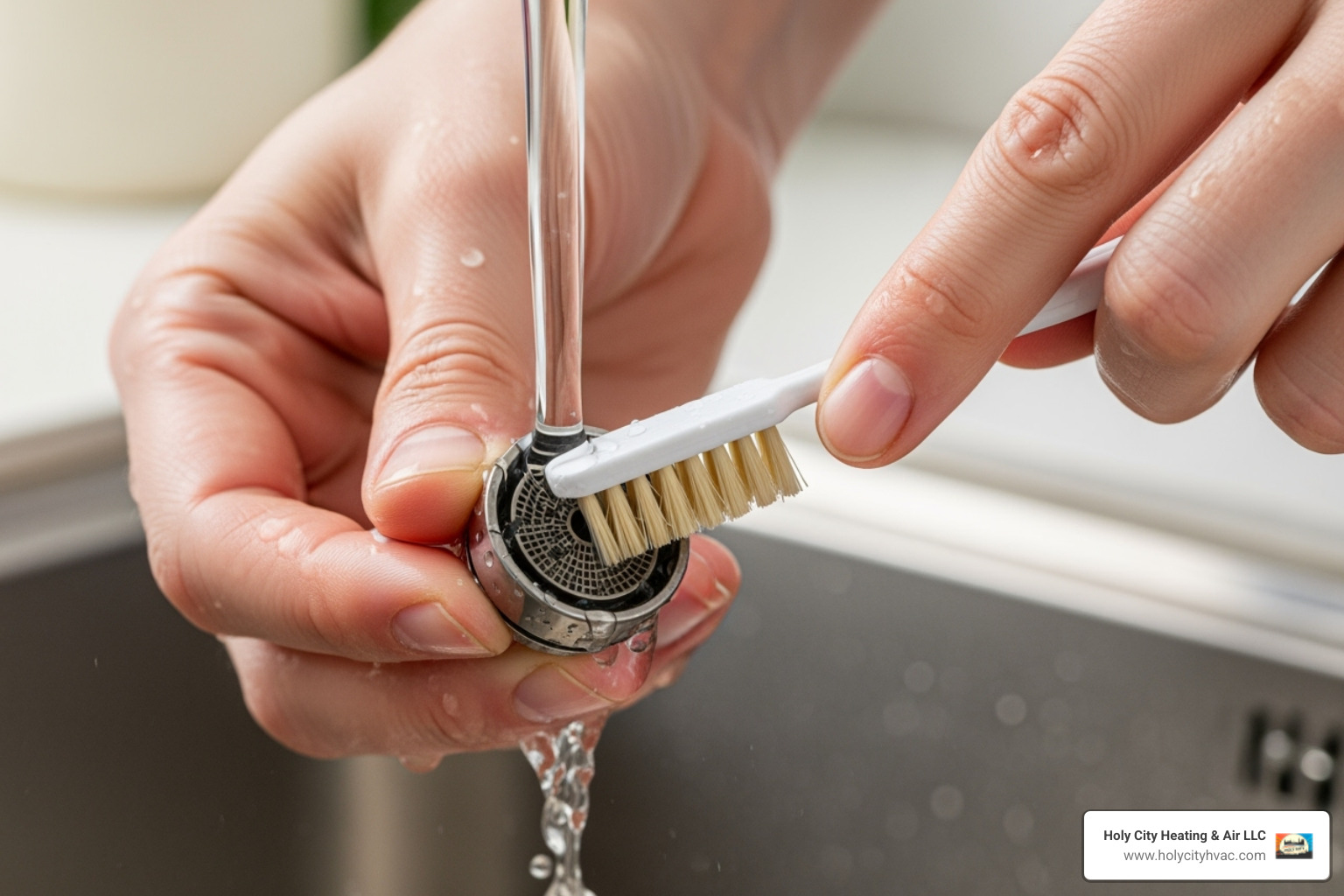
Simple Fixes for Immediate Improvement
Start with these simple fixes that often yield great results.
Cleaning aerators and showerheads is the most common fix. These small screens easily clog with mineral buildup. Unscrew the aerator or showerhead and soak the parts in white vinegar overnight. The acid will dissolve the deposits. In the morning, scrub them with an old toothbrush, rinse, and reinstall. This simple step can often restore a strong flow.
Checking that all shut-off valves are fully open is a simple but crucial step. Check your main water shut-off valve and the smaller valves under sinks and behind toilets. Turn them completely counterclockwise to ensure they are fully open. For gate valves, open them fully, then turn back a quarter turn to prevent seizing.
Inspecting for obvious leaks can reveal the source of your pressure loss. Check under sinks, behind toilets, and near your water heater for drips, puddles, or water stains. A small, steady leak can significantly reduce your system's pressure.
Advanced Solutions for Persistent Issues
If simple fixes don't work, you may need to consider more advanced solutions.
A water pressure booster pump can be an effective solution for chronically low municipal pressure, especially in high-elevation areas. These devices increase the pressure of water entering your home. However, proper sizing and installation are critical to avoid damaging your plumbing.
Adjusting your pressure regulator can be effective, but it's not a recommended DIY job. Setting the pressure too high can damage pipes and appliances, while setting it too low won't solve the problem. This task is best left to a professional.
Bypassing your water softener is a good diagnostic step. Use the bypass valve on your unit to let water flow around the system. If your pressure immediately improves, your softener needs service or replacement.
When you've tried these solutions and your low water pressure persists, or if you find complex issues like corroded pipes or hidden leaks, it's time to bring in the professionals. At Holy City Heating & Air, we've been solving Charleston area plumbing puzzles for years, and we know exactly how to diagnose and fix even the trickiest pressure problems. Our experienced team can save you time, frustration, and potentially costly mistakes from DIY attempts on complex plumbing systems.
Frequently Asked Questions about Water Pressure
Here are answers to some of the most common questions we hear from Charleston homeowners about low water pressure.
What is the ideal water pressure for a home?
The ideal water pressure for a home is between 45 and 55 PSI. This range provides a strong flow without being so powerful that it damages plumbing. While the normal range is 40 to 60 PSI, pressure below 40 PSI is considered low water pressure and can make appliances like dishwashers and washing machines work inefficiently.
Conversely, pressure above 70 PSI is too high and can damage pipes, create leaks, and cause premature wear on appliances. If your pressure is consistently high, a pressure-reducing valve is recommended to protect your plumbing system.
Can a water softener cause low water pressure?
Yes, a water softener can cause low water pressure. The resin bed inside can become clogged with sediment, or an undersized unit may not be able to keep up with your household's demand, restricting flow.
While temporary pressure drops during the softener's regeneration cycle are normal, persistent low pressure is not. Most water softeners last 10 to 15 years; as they age, performance can decline. You can test if your softener is the problem by using its bypass valve. If pressure improves when the softener is bypassed, the unit likely needs cleaning, new resin, or replacement.
How do I know if my water pressure regulator is faulty?
A failing pressure regulator has several tell-tale signs.
Fluctuating pressure is the most common symptom—swinging from a weak trickle to a powerful blast. A sudden, house-wide pressure drop after a long period of normal pressure also points to a faulty regulator. You might also hear humming, vibrating, or banging noises from your pipes when water is running.
Regulators typically last 10 to 20 years. If yours is old and you're experiencing low water pressure, replacement is often the best solution. Adjusting or replacing a pressure regulator requires proper calibration to protect your plumbing, so it's a job best left to our experienced team.
When to Call a Professional Plumber
Sometimes, despite your best DIY efforts, low water pressure problems need the expertise of a professional plumber. Knowing when to put down your tools and pick up the phone can save you from headaches, costly mistakes, and even property damage.
If you've worked through all our troubleshooting steps and your low water pressure is still driving you crazy, it's time to call in the pros. Persistent pressure problems throughout your home often point to issues that require specialized tools and knowledge to diagnose properly.
Hidden leaks are particularly tricky. You might notice all the warning signs - mysterious water stains, unexplained spikes in your water bill, or that unsettling sound of running water when everything's turned off - but tracking down the actual source can be like finding a needle in a haystack. Professional plumbers have leak detection equipment that can pinpoint problems behind walls, under concrete slabs, or in other hard-to-reach places without tearing your house apart.
Faulty pressure regulators are another area where professional help is essential. These devices control the pressure entering your entire home, and adjusting them incorrectly can create dangerous conditions. Too much pressure can burst pipes or damage appliances, while too little leaves you back where you started. Our technicians have the right tools and experience to test, adjust, or replace pressure regulators safely.
If your home has old galvanized steel pipes that are corroding from the inside out, the only real solution is often a complete repiping job. This isn't a weekend DIY project - it requires careful planning, permits, and the skill to reroute plumbing without disrupting your daily life more than necessary.
Complex systems like well pumps, combi boilers, or whole-house water treatment systems also benefit from professional attention. These setups have multiple components that work together, and troubleshooting them requires understanding how each piece affects the others.
Here's the thing - we believe in empowering homeowners to tackle what they can handle. But we also want you to feel confident and safe in your home. If you're ever unsure about a plumbing issue, or if something just doesn't feel right, trust your instincts and give us a call.
Holy City Heating & Air has been a family-owned company proudly serving Charleston and surrounding areas since 2015, backed by over 20 years of industry expertise. Our EPA-certified, licensed professionals deliver top-quality solutions that go beyond just heating and cooling - we're here for all your home comfort needs, including comprehensive plumbing services.
We combine the resources of a growing company with the personal care of a local business. We invest in our team so our customers receive best service every time. Rooted in the community, we prioritize integrity, customer satisfaction, and long-lasting comfort for every home we serve.
For expert assistance with your low water pressure issues, contact us today. We're proud to offer Expert plumbing services in North Charleston and across the greater Charleston area, including Kiawah Island, Johns Island, Mt Pleasant, Daniel Island, Edisto Island, Folly Beach, Goose Creek, Hollywood, Isle of Palms, James Island, Ravenel, Seabrook, Sullivan's Island, Summerville, Wadmalaw, and West Ashley. We're here to turn your drip into delight!
Recent posts






